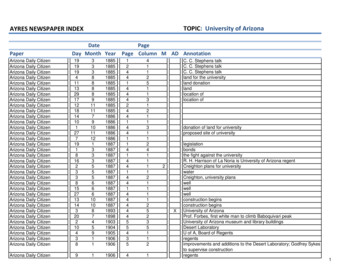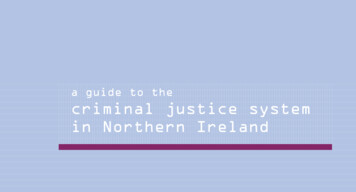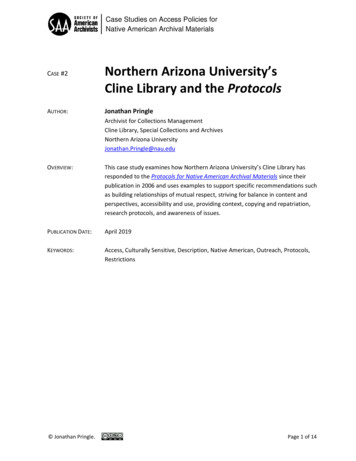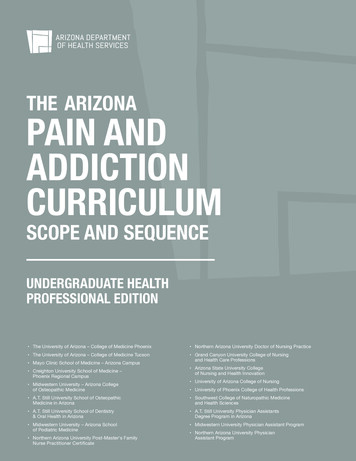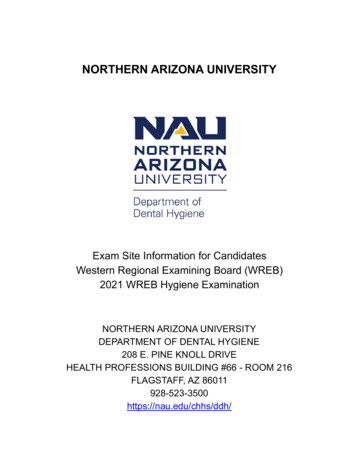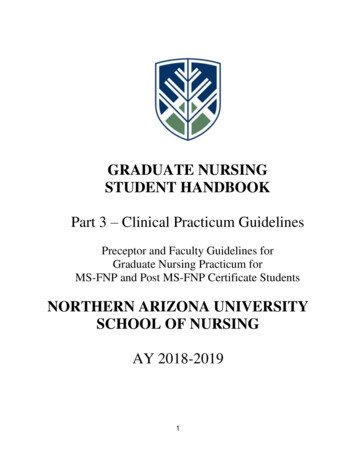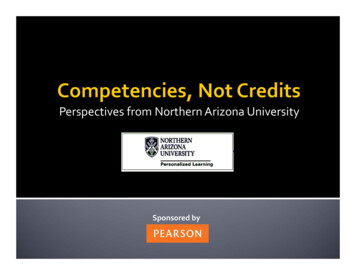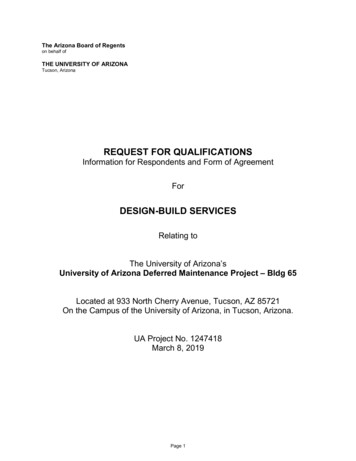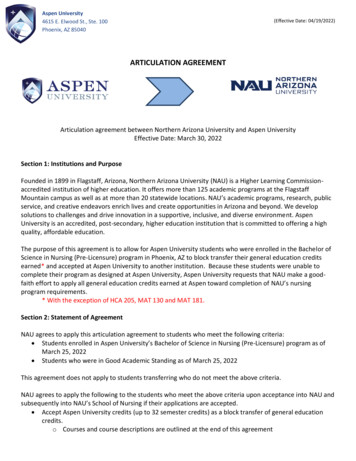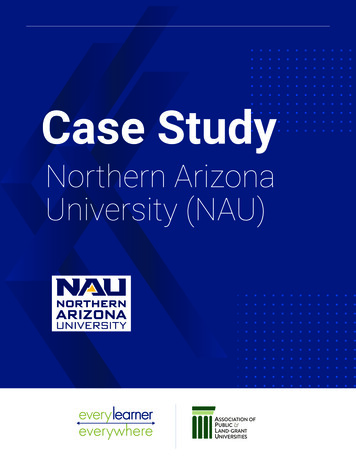
Transcription
Case StudyNorthern ArizonaUniversity (NAU)
Case Study – Northern Arizona UniversityContentsAbout the Contributors3About the Supporting Organizations3Introduction4Key TakeawaysGoal56Approach6Relevant Findings7Future Directions10Citing this ResourceTesene, M. and Charleston, K. (2020, March 24) Case Study Northern Arizona University [Case Study]Association of Public & Land-grant Universities and Every Learner Everywhere. ase-study-northern-arizona-university/ 2
Case Study – Northern Arizona UniversityAbout the ContributorsAuthorsMegan Tesene, PhDDirector of the Personalized Learning Consortium at the Association of Public and Land-grant UniversitiesKayla Charleston, PhDORISE Fellow/Research Analyst Army Public Health CenterAbout the SupportingOrganizationsEvery Learner Everywhere is a network of twelve partner organizations with expertise inevaluating, implementing, scaling, and measuring the efficacy of education technologies,curriculum and course design strategies, teaching practices, and support services thatpersonalize instruction for students in blended and online learning environments. Ourmission is to help institutions use new technology to innovate teaching and learning,with the ultimate goal of improving learning outcomes for Black, Latinx, and Indigenousstudents, poverty-affected students, and first-generation students. Our collaborativework aims to advance equity in higher education centers on the transformation ofpostsecondary teaching and learning. We build capacity in colleges and universitiesto improve student outcomes with digital learning through direct technical assistance,timely resources and toolkits, and ongoing analysis of institution practices andmarket trends. For more information about Every Learner Everywhere and itscollaborative approach to equitize higher education through digital learning, visit www.everylearnereverywhere.org.Association of Public and Land-grant Universities (APLU) is a research, policy, andadvocacy organization dedicated to strengthening and advancing the work of publicuniversities in the U.S., Canada, and Mexico. With a membership of 244 public researchuniversities, land-grant institutions, state university systems, and affiliated organizations,APLU’s agenda is built on the three pillars of increasing degree completion and academicsuccess, advancing scientific research, and expanding engagement. Annually, membercampuses enroll 5 million undergraduates and 1.3 million graduate students, award1.3 million degrees, employ 1.3 million faculty and staff, and conduct 49.2 billion inuniversity-based research.Materials are freely available on the Every Learner Everywhere website and licensed under a CreativeCommons Attribution-No Derivatives 4.0 International License. 3
IntroductionAt Northern Arizona University, 46% of freshmen are first-generation college students. Foundationalfirst-year and introductory classes are vital to student success. NAU realized that helping first-generation students succeed would require improving first-year course experiences. As a result, nearlya decade ago they created the First-Year Learning Initiative (FYLI) with the goal of fostering successamongst first-year students. The faculty-driven initiative requires course coordinators who follow aset of principles in coordinating all sections of the 75 courses in the program. These courses havebeen designed to focus on three critical areas for student success: establishing necessary skills andbehaviors; incorporating support features such as frequent feedback and formative assessment;and ensuring consistency across sections and semesters. The university’s student body consistsof a 61% female, 23% Hispanic, and 4% Native American population. Combined with the significantnumber of first-generation students, this inspired NAU to pursue methods and tools to increase success and retention of its underserved student population.
Case Study: NorthernArizona University(NAU)This case study from Northern Arizona University demonstrates the increase in student success, as measured through pass rates, that can result from the implementation of adaptivecourseware across all sections of selected first- and second-year courses.Key TakeawaysThe implementation of adaptive courseware atNorthern Arizona University (NAU) resulted in anincrease in pass rates in affected courses from 84%to 88% between the Fall of 2017 and the Spring of2019.NAU’s approach was to redesign courses andimplement adaptive courseware similarly acrossall sections of a course. In an effort to set andcommunicate high standards of learning in lowerdivision coursework consistently across sections,all but two of the adaptive courses discussed in thisstudy shared the following: Team of course coordinators Master syllabus Course purpose Learning outcomes Assessment philosophy, if not specificassessments content, although not necessarilyidentical readings and learning materials.About the School and GrantAbout the SchoolNorthern Arizona University (NAU) is apublic university with a main campusin Flagstaff, Arizona. It serves over31,000 students, including nearly 2,000on community campuses statewide andnearly 6,000 online. NAU is a memberinstitution of the Association of Publicand Land-grant Universities (APLU).About the GrantNAU also received funding under the APLU’s 2016 Accelerating the Adoption ofAdaptive Learning Grant. This grant aimsnot only to facilitate the implementationof adaptive courseware in public universities but also to improve outcomes forunderserved student populations. 5
Case Study – Northern Arizona UniversityGoalThe use of Active and Adaptive Learning at NAU was intended to continue to support the FYLI. Dueto its successful FYLI work, faculty and departments were primed to continue to improve studentsuccess by leveraging adaptive courseware and course redesign. NAU’s goal was to effectivelyimplement adaptive courseware for 28 of its introductory Liberal Studies (general education) coursesin 48 months. They aspired to transfer lessons learned and faculty expertise to transform theirblended and online programs. In doing so, NAU sought to understand individual student learning. Theirprimary objective was to design the courses to maximize student success, which included figuring outkey concepts and content, then building in opportunities to personalize learning such that studentscould spend the time they needed on areas with the most room for improvement.ApproachAlong with managing different aspects of the project, program managers play the pivotal role ofbuilding and maintaining relationships with instructors and departments involved in the project. Inestablishing a collaborative process, program managers are able to create a sense of ownershipfor faculty and other stakeholders who feel they are working as a team to meet implementationgoals. NAU benefitted from this effective leadership model, which fostered vital communication andcoordination between departments and stakeholders.NAU is at the forefront of making use of course coordinators. Course coordinators use their expertiseto organize instructional materials, assessments, and make courseware implementation decisionsthat will best suit the student body. The success of NAU’s foundational business course, Introductionto Computer Information Systems, was due to a strong faculty team led by a knowledgeable andengaged course coordinator. Together, the team developed a course design reflective of student needsand course learning goals. Geological Disasters was another highly supported course that quicklybecame a favorite amongst students. Courses with the most support have garnered enthusiasticreviews.A student enrolled in Geological Disasters said:The before and after class assignments are helping me know and reflect on material we are learning.Some degree of faculty and leadership turnover is expected during projects of this magnitude.Fortunately, maintaining momentum and active support in this initiative was relatively uncomplicateddue to the strong relationships established across the various institutional participants anddepartments. By focusing on a course-by-course model, NAU thoughtfully engaged core faculty,course coordinators and department chairs. This approach served to embed the FYLI and adaptivecourseware improvements into the culture, ensuring sustainability even in the midst of leadershipchange. 6
Case Study – Northern Arizona UniversityThe university also utilized Instructional Designers (IDs) for direct teaching and mentoring support forfaculty in the process of courseware adoption. Since the start of the grant, two of NAU’s primary IDsretired. In their absence, the university has adapted alternative support activities that emphasize andencourage excellent teaching practices. These include having as many faculty members as possiblecomplete the Association of College and University Educators (ACUE) teaching program. NAU hasfound these alternative options effective and recognizes that adaptive courseware technology simplyamplifies the underlying quality of instruction.Faculty engagement was essential in each stage of the Adaptive Program. NAU has conducted aseries of activities to promote a campus culture receptive to adaptive learning. It began with a 2-½ daykick-off event in August 2016. This workshop-styled event included a vendor showcase and 30 facultyrepresenting 14 of their target courses. In subsequent years, the university has used conferences,orientations and learning communities organized around adaptive learning.Learning communities allowed faculty to share their experiences, creating beneficial conversationsacross disciplines and universities. These learning communities are part of NAU’s collaborativeprocess to create teams of invested faculty and instructional designers. There are as many as eightfaculty teaching different sections of courses. During implementation these faculty would meet anddiscuss ideas for further course development, underscoring the need for working with others to reachoptimal outcomes.The university established the necessity for academic leadership to have regular reports and ongoingorientation. Additionally, their program manager offered incentives to maintain faculty buy-in. NAUstrived to keep stakeholders at all levels informed and invested in achieving adaptive coursewaregoals.The university established the necessity for academic leadership to have regular reports and ongoingorientation. Additionally, their program manager offered incentives to maintain faculty buy-in. NAUstrived to keep stakeholders at all levels informed and invested in achieving adaptive coursewaregoals.Relevant FindingsIn Fall 2016, NAU began implementation with two courses, with a combined 11 sections, employingadaptive courseware. By the following Fall 2017 they had tripled the number of courses offeringadaptive learning, climbing to six courses — a total of 43 sections. As of Fall 2019, the numbers havereached 26 courses with 211 corresponding sections. As part of the adaptive learning grant thatfunded this work, NAU was tasked with scaling to 15% of their general education enrollments withinthree years. NAU has achieved scale overall, with almost 25% of their enrollments in introductorygeneral education classes using adaptive courseware. In 18 of the 26 courses, all sections areadaptive and are consequently at scale at the course level. Of the 228 total sections offered, 211 ofthem are adaptive. 7
Case Study – Northern Arizona UniversityWith careful design and effective integration of adaptive activities into the curriculum of a course, NAUfound that student experiences and outcomes greatly improved. Geologic Disasters demonstratesthe benefits of one such successful course. From Spring 2017 to Spring 2019 the overall pass rateincreased from 84% to 88%. Broken down by demographics, adaptive courseware implementationincreased pass rates from 76% to 85% for Hispanic students, 79% to 92% for first-generation students,and an incredible 62% to 82% for Black students.In conjunction with improved student experiences, faculty also found well-designed adaptive learningcourses to be useful for teaching and pedagogy. Faculty enjoyed the data and reporting, as it allowedthem to identify problematic content and struggling students, with a necessary distinction madebetween the two. They were then able to pinpoint a proper intervention in each case. Overall, whenstudents understood their role and the role of adaptive courseware, faculty were surprised and happyto find that more students were coming to class prepared. 8
Case Study – Northern Arizona UniversityDon Carter, ASU’s Director of Academic & Research Technology Services, said:[Adaptive courseware] takes some of the remedial and mundanework that students simply have to do outside of the class so thatwhen they do meet with other students and faculty, they havehigher value interactions.Results for Spring 2019 show cumulatively across all adaptive courses a pass rate increaseof 5.2% for highly supported courses since implementing active and adaptive pedagogy. Passrates are defined as achieving an A, B or C in the course. In the 2018-2019 school year, adaptiveredesigns helped over 700 students pass courses they otherwise would not have passed withoutuse of these redesigns. As an added success of NAU’s adaptive learning strategies, passing theseclasses means that students are able to save time and money and continue progressing throughtheir degree programs.CoursePercent Increase Since AdaptiveChange in # PassingPost-AdaptiveUnity of Life I: Cell Metabolism6%140Personal Finance in a GlobalEconomyGeologic Disasters9%154%80World History I3%9Introduction to ComputerInformation SystemsMathematics Pathway5%9030%135Introduction to Nutrition andFoodsIntroduction to Psychology7%653%95Developmental Psychology7%75Introduction to Sociology2%20 9
Case Study – Northern Arizona UniversityFuture DirectionsNAU has a multi-pronged plan for moving forward with expansion and scaling. Their approach consists offour components. First, they have set out to write course specific teachers’ guides designed to help newfaculty assigned to teach redesigned courses. The intention is to keep the momentum they have established. They will also continue focusing on the core features of good teaching to improve the current cropof courses. Next, they will support expansion to upper level and online courses, especially their competencyprogram known as NAU Personalized Learning Program. Finally, a new development is to work on an alternative credentialing effort (digital badging) for continuing education and a noncredit skills-based curriculumfor workforce development.NAU’s results show a promising future for the implementation of adaptive learning courseware. A vital component of their success has been the culture of shared curriculum, for which the FYLI laid the foundation. 10
Northern Arizona University (NAU) is a public university with a main campus in Flagstaff, Arizona. It serves over 31,000 students, including nearly 2,000 on community campuses statewide and nearly 6,000 online. NAU is a member institution of the Association of Public and Land-grant Universities (APLU). About the Grant

